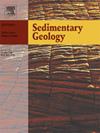不同力学性能的颗粒和块状材料的滑坡运动与筑坝沉降试验研究
IF 2.9
2区 地球科学
Q1 GEOLOGY
引用次数: 0
摘要
本研究探讨了不同含水率和粒径的粒状物质,以及不同体积和层强度的块体物质对滑坡破碎、运动和沉积的影响。试验结果表明,随着粒径的增大,最大坝高(Hmax)和坝宽(Wmax)增大,最小坝高(Hmin)减小,表明滑坡体坝的稳定性得到改善。较大的颗粒尺寸对水分含量的变化不太敏感。此外,水分含量抑制Wmax,与单一粒径材料相比,混合粒径材料显示出更大的减少。随着Wmax的增大,最大坝长Lmax呈指数递减。滑动时间(Ts)、沉积时间(Td)和总时间(T)随粒径的增大而减小。对于混合粒径材料,粒径分布更加连续,进一步降低了Ts、Td、T。砌块材料实验表明,随着砌块体积的增大,Wmax、Lmax、Hmax显著增大,Ts、Td、T也相应增大。下层材料强度降低,Wmax、Hmax减小,Ts、Td、T增大。相反,当下层材料强度增加时,观察到相反的效果。摩擦能量损失(Ef)是主要的能量损失途径,总能量损失和Ef都随着粒径的增大而减小。局部能量损失主要是由于地形碰撞造成的,与水分含量无关。本文章由计算机程序翻译,如有差异,请以英文原文为准。
Experiments study on landslide motion and damming deposit for particle and block materials with different mechanical properties
This study explores the impact of granular materials with varying moisture contents and particle sizes, as well as block materials with different volumes and layer strengths, on landslide fragmentation, motion, and deposit. The experimental results show that as particle size increases, the maximum dam height (Hmax) and width (Wmax) increase, while the minimum dam height (Hmin) decreases, indicating an improvement in the stability of landslide dams. Larger particle sizes are less sensitive to changes in moisture content. Additionally, moisture content inhibits Wmax, with mixed particle-size materials showing a greater reduction compared to single particle-size materials. As Wmax increases, the maximum dam length (Lmax) decreases exponentially. Sliding time (Ts), deposition time (Td), and total time (T) decrease as particle size increases. For mixed particle-size materials, a more continuous particle size distribution further reduces Ts, Td, and T. Block material experiments show that with increasing block volume, Wmax, Lmax, and Hmax increase significantly, with corresponding increases in Ts, Td, and T. When the strength of the lower layer material decreases, Wmax and Hmax decrease, while Ts, Td, and T increase. Conversely, when the lower layer material strength increases, the opposite effect is observed. Frictional energy loss (Ef) is the primary energy loss pathway, with both total energy loss and Ef decreasing with increasing particle size. Localized energy losses are mainly due to terrain collisions, independent of moisture content.
求助全文
通过发布文献求助,成功后即可免费获取论文全文。
去求助
来源期刊

Sedimentary Geology
地学-地质学
CiteScore
5.10
自引率
7.10%
发文量
133
审稿时长
32 days
期刊介绍:
Sedimentary Geology is a journal that rapidly publishes high quality, original research and review papers that cover all aspects of sediments and sedimentary rocks at all spatial and temporal scales. Submitted papers must make a significant contribution to the field of study and must place the research in a broad context, so that it is of interest to the diverse, international readership of the journal. Papers that are largely descriptive in nature, of limited scope or local geographical significance, or based on limited data will not be considered for publication.
 求助内容:
求助内容: 应助结果提醒方式:
应助结果提醒方式:


